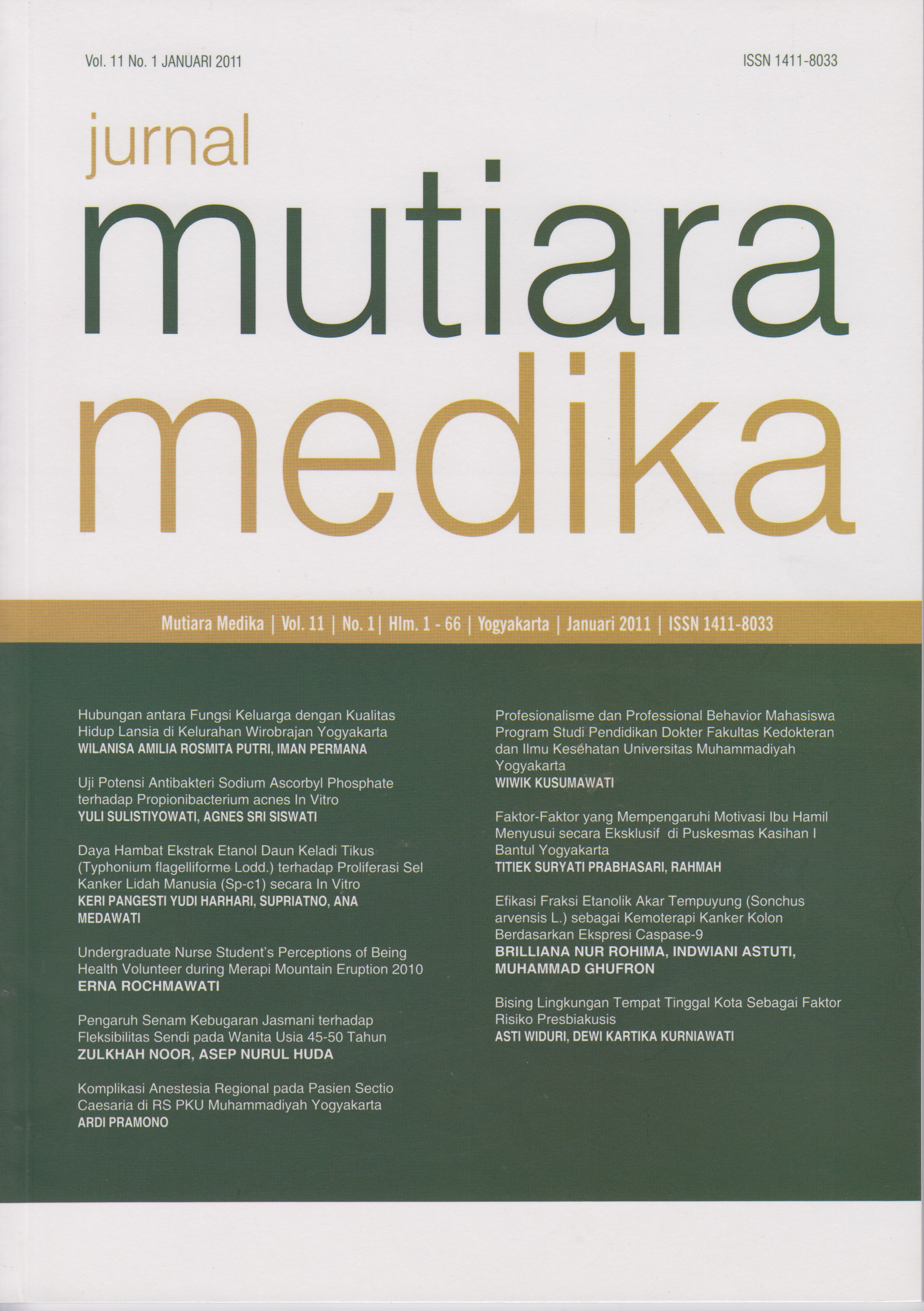Uji Potensi Antibakteri Sodium Ascorbyl Phosphate terhadap Propionibacterium acnes In Vitro
DOI:
https://doi.org/10.18196/mmjkk.v11i1.930Keywords:
Akne vulgaris, Propionibacterium acnes, Sodium Ascorbyl Phosphate, kadar hambat minimalAbstract
Akne vulgaris adalah gangguan pada unit pilosebaseus yang sering terjadi pada dewasa muda. Propionibacterium acnes adalah bakteri anaerob yang merupakan flora folikel dan berperan penting dalam patogenesis akne. Sodium Ascorbyl Phosphate (SAP) merupakan bentuk phosphate ester ascorbic acid yang mudah diserap oleh kulit, sehingga sering digunakan dalam produk kosmetik baik sebagai senyawa tunggal maupun campuran. Apabila senyawa ini terbukti mempunyai pengaruh terhadap jumlah koloni P. acnes, maka SAP dapat digunakan sebagai salah satu obat alternatif antiakne. Tujuan penelitian adalah untuk mengetahui kadar minimal SAP yang dapat menghambat pertumbuhan P. acnes invitro. Penelitian dilakukan secara eksperimental lab dengan bahan uji SAP yang dibuat dalam konsentrasi 0,5%, 1%, 1,5%, 2%, 2,5 %, 3%, 3,5%, 4%, 4,5 % kadar hambat minimal SAP terhadap P. acnes dengan metode dilusi cair. Penelitian ini dilakukan pengulangan sebanyak 3 kali. P. acnes cair di dapatkan dari Laboratorium Mikrobiologi FK UGM. Hasil penelitian menunjukkan bahwa kadar hambat minimal SAP terhadap Propionibacterium acnes adalah 2,5 % b/v. Dari penelitian ini dapat disimpulkan bahwa SAP memiliki potensi antibakteri terhadap Propionibacterium acnes.
References
Thiboutot D. Regulation of Human Sebaceous Glands. The Journal of Investigative Dermatology 2004;123:1-12
Pawin, H, Beylot C, Chivot M, et al., 2004. Physiopathology of acne vulgaris : recent data, new understanding of the treatments. Eur J Dermatol 2004;14:4-12
Freedberg IM, Eisen AZ, Wolf K, Austen KF, Goldsmith LA, Kats SI. Fitzpatrick’s Dermatology in General Medicine. Edisi ke-6. Volume ke-2. New York: McGrawHill; 2003.
Klock J, Ikeno H, Ohmori K, Nishikawa J, Vollhardt J, Schelmann V. 2005. Sodium Ascorbyl Phosphate shows invitro and invivo efficacy in the prevention and treatment of acne vulgaris. Int J of Cosmetics Sci 2005;27:171-176
Klock J. Sodium Ascorbyl Phosphate has still unexploited potential in cosmetics. SOFW. 2004;130:46-56
Shibayama H, Ueda K, Yoshio K, Matsuda S, Hisama M, Miyazawa M. Synthesis and characterization of new ascorbic derivatives Sodium isostearyl 2-O-L-Ascorbyl Phosphate. J of Oleo Science 2005;54:601-608
Fite A, Dykhuizen R, Litterick A, Golden M, Leifert C. Effects of Ascorbic acid, gluthathione, thiocyanate, and iodide on antimicrobial activity of acidified nitrite. Antimicrob Agents Chemother 2004;48:655-658
Ristanto. Uji Bakterisidal, dalam Buku Petunjuk Praktikum Mikrobiologi, Laboratorium Mikrobiologi Fakultas Kedokteran Universitas Gadjah Mada.1998.
Lennette EH, Balows A, Hausler WJ, Shadomy HJ. Manual of Clinical Microbiology. 4th ed. American Society for Mycrobiology. Washington DC. 1985.
Downloads
Published
Issue
Section
License
Copyright
Authors retain copyright and grant Mutiara Medika: Jurnal Kedokteran dan Kesehatan (MMJKK) the right of first publication with the work simultaneously licensed under an Attribution 4.0 International (CC BY 4.0) that allows others to remix, adapt and build upon the work with an acknowledgment of the work's authorship and of the initial publication in Mutiara Medika: Jurnal Kedokteran dan Kesehatan (MMJKK).
Authors are permitted to copy and redistribute the journal's published version of the work (e.g., post it to an institutional repository or publish it in a book), with an acknowledgment of its initial publication in Mutiara Medika: Jurnal Kedokteran dan Kesehatan (MMJKK).
License
Articles published in the Mutiara Medika: Jurnal Kedokteran dan Kesehatan (MMJKK) are licensed under an Attribution 4.0 International (CC BY 4.0) license. You are free to:
- Share — copy and redistribute the material in any medium or format.
- Adapt — remix, transform, and build upon the material for any purpose, even commercially.
This license is acceptable for Free Cultural Works. The licensor cannot revoke these freedoms as long as you follow the license terms. Under the following terms:
Attribution — You must give appropriate credit, provide a link to the license, and indicate if changes were made. You may do so in any reasonable manner, but not in any way that suggests the licensor endorses you or your use.
- No additional restrictions — You may not apply legal terms or technological measures that legally restrict others from doing anything the license permits.






